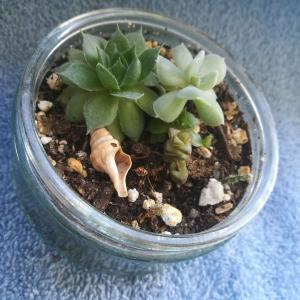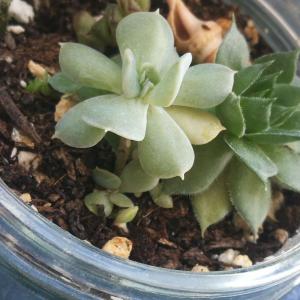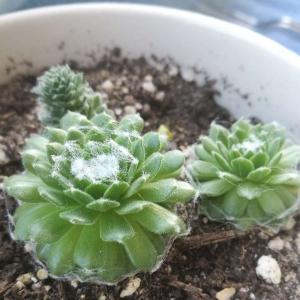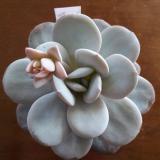成长记
Ueca
2018年04月22日

One winter later, the shoots are looking big and healthy. So is mama plant!
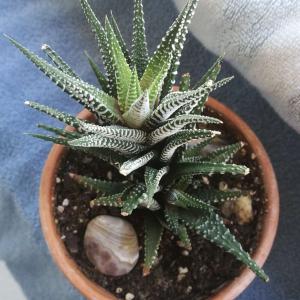
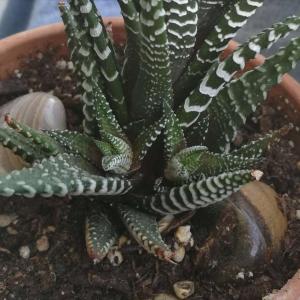
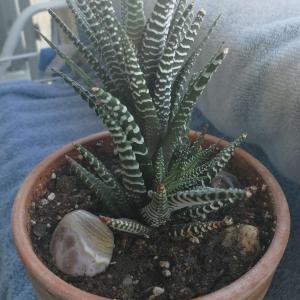



0
0
文章
Miss Chen
2018年04月20日

Acorn squash (Cucurbita pepo) is an annual vining winter squash plant that produces ribbed fruit with green or gold rinds. When harvested ripe, the fruits store for about three months. To determine if an acorn squash is ripe, consider the appearance and texture of its skin, the condition of the vine and the number of days since sowing.

Skin Appearance
An orange patch appears on the area of the acorn squash that rests on the ground when the fruit is ripe, and skin is matte. An immature acorn squash is shiny. As the fruit ripens, it loses its shine and looks dry and dull.
Skin Texture
A ripe acorn squash has a very tough skin. To test whether an acorn squash is ripe, try to pierce the skin with your thumbnail. Your nail won't easily leave a mark on a ripe acorn squash.
Vine Condition
As an acorn squash matures, the vine deteriorates. When an acorn squash plant turns yellow and dies back, the fruit are usually ripe.
Harvest Time
Acorn squash are usually ready to harvest about 80 to 100 days after sowing. The seeds are sown in spring after the final local average frost date, and the fruits mature as fall approaches.

Unripe Fruit
An unripe acorn squash doesn't ripen after harvest. Acorn squash fruit texture and flavor develops as the fruit ripens. Unripe fruit are watery and taste bland, and store badly.
'Jersey Golden Acorn'
'Jersey Golden Acorn' is an acorn squash variety that produces fruit that can be picked unripe without losing flavor. The flesh of this variety is sweet when the fruit is golfball-sized, and the skin is soft. You can eat unripe 'Jersey Golden Acorn' fruit raw or cooked.
Fruit Harvest
Harvest acorn squash by cutting the stem 1 inch from the fruit, and store the fruit in a dry place at 50 degrees Fahrenheit. An acorn squash fruit stores best at 50 to 75 percent humidity.

Skin Appearance
An orange patch appears on the area of the acorn squash that rests on the ground when the fruit is ripe, and skin is matte. An immature acorn squash is shiny. As the fruit ripens, it loses its shine and looks dry and dull.
Skin Texture
A ripe acorn squash has a very tough skin. To test whether an acorn squash is ripe, try to pierce the skin with your thumbnail. Your nail won't easily leave a mark on a ripe acorn squash.
Vine Condition
As an acorn squash matures, the vine deteriorates. When an acorn squash plant turns yellow and dies back, the fruit are usually ripe.
Harvest Time
Acorn squash are usually ready to harvest about 80 to 100 days after sowing. The seeds are sown in spring after the final local average frost date, and the fruits mature as fall approaches.

Unripe Fruit
An unripe acorn squash doesn't ripen after harvest. Acorn squash fruit texture and flavor develops as the fruit ripens. Unripe fruit are watery and taste bland, and store badly.
'Jersey Golden Acorn'
'Jersey Golden Acorn' is an acorn squash variety that produces fruit that can be picked unripe without losing flavor. The flesh of this variety is sweet when the fruit is golfball-sized, and the skin is soft. You can eat unripe 'Jersey Golden Acorn' fruit raw or cooked.
Fruit Harvest
Harvest acorn squash by cutting the stem 1 inch from the fruit, and store the fruit in a dry place at 50 degrees Fahrenheit. An acorn squash fruit stores best at 50 to 75 percent humidity.
0
0
文章
Miss Chen
2018年04月15日

Spaghetti squash, one of the common and popular winter squash varieties, grows into a large oval squash with a yellow or orange skin. Most spaghetti squash varieties mature in three to four months. If you lack garden space, grow a vine variety of spaghetti squash on a trellis to conserve soil area. Because the spaghetti squash become quite large as they mature, rig a support system for the growing squash.

Step 1
Prepare a sunny growing location after the final spring frost. Cultivate the soil with the garden spade down to a depth of 6 to 8 inches. Add 4 inches of compost to the top of the soil and work the compost and the soil completely to mix them. Rake the soil surface smooth.
Step 2
Insert the wood or metal trellis system into the soil. Pound the bottom of the trellis into the soil with a hammer to drive it at least 8 inches into the ground.
Step 3
Plant the spaghetti squash seeds along both sides of the trellis, positioning the seeds four to six inches from the trellis. Sow two seeds together about 1 inch deep, spacing the seeds about 12 inches apart. Cover the seeds lightly with soil.
Step 4
Water the seeds generously immediately after planting and keep the soil moist while the seeds germinate – about one to two weeks. Provide water for the growing spaghetti squash plants if less than 1 inch of rain falls in a one-week period.

Step 5
Thin the seedlings when they reach a height of 4 inches. Remove the weakest seedlings to leave one plant growing every 12 inches along the trellis.
Step 6
Apply the fertilizer to the seedlings by sprinkling 1/4 lb. of granular fertilizer for every 10 feet of seedlings. Apply the fertilizer approximately three weeks after you see the first blossoms and work the fertilizer into the soil well with a hand rake.
Step 7
Pull weeds as they appear, to keep the soil area free of competing plants.
Step 8
Tie the vines to the trellis with the stretchy plant ties to train the vines. Support the main vines by tying them loosely to the trellis.
Step 9
Cut a 2-foot length of cheesecloth for each spaghetti squash that begins to grow on the plants. Tie the cheesecloth so it acts as a sling for the squash and tie the ends of the cheesecloth to the trellis.
Step 10
Harvest spaghetti squash before the first autumn frost, when the skins turn yellow. The skin should feel firm to the touch. Use a sharp knife to cut the squash from the vines, leaving about 3 inches of vine protruding from the squashes.

Step 1
Prepare a sunny growing location after the final spring frost. Cultivate the soil with the garden spade down to a depth of 6 to 8 inches. Add 4 inches of compost to the top of the soil and work the compost and the soil completely to mix them. Rake the soil surface smooth.
Step 2
Insert the wood or metal trellis system into the soil. Pound the bottom of the trellis into the soil with a hammer to drive it at least 8 inches into the ground.
Step 3
Plant the spaghetti squash seeds along both sides of the trellis, positioning the seeds four to six inches from the trellis. Sow two seeds together about 1 inch deep, spacing the seeds about 12 inches apart. Cover the seeds lightly with soil.
Step 4
Water the seeds generously immediately after planting and keep the soil moist while the seeds germinate – about one to two weeks. Provide water for the growing spaghetti squash plants if less than 1 inch of rain falls in a one-week period.

Step 5
Thin the seedlings when they reach a height of 4 inches. Remove the weakest seedlings to leave one plant growing every 12 inches along the trellis.
Step 6
Apply the fertilizer to the seedlings by sprinkling 1/4 lb. of granular fertilizer for every 10 feet of seedlings. Apply the fertilizer approximately three weeks after you see the first blossoms and work the fertilizer into the soil well with a hand rake.
Step 7
Pull weeds as they appear, to keep the soil area free of competing plants.
Step 8
Tie the vines to the trellis with the stretchy plant ties to train the vines. Support the main vines by tying them loosely to the trellis.
Step 9
Cut a 2-foot length of cheesecloth for each spaghetti squash that begins to grow on the plants. Tie the cheesecloth so it acts as a sling for the squash and tie the ends of the cheesecloth to the trellis.
Step 10
Harvest spaghetti squash before the first autumn frost, when the skins turn yellow. The skin should feel firm to the touch. Use a sharp knife to cut the squash from the vines, leaving about 3 inches of vine protruding from the squashes.
0
0
文章
Miss Chen
2018年04月09日

Eggplant (Solanum melongena) is winter hardy and perennial in U.S. Department of Agriculture plant hardiness zones 9 to 12, but in most parts of the country it is grown as an annual garden vegetable. It is not tolerant of cold temperatures, and for good fruit development, it requires a long frost-free growing season. The plant is thought to have originated in India more than 1,500 years ago and to have come to North America with Spanish explorers sometime before the 19th century.
Seedlings
Eggplant seeds take one to two weeks to germinate after they're planted, and seedlings will be big and sturdy enough to transplant outdoors within six to 10 weeks after germination. Young plants are vulnerable to damage from frost and cold temperatures, so seedlings shouldn't be transplanted until the soil is warm, nighttime temperatures are consistently above 65 degrees Fahrenheit, and all danger of frost has passed.

Mature Plants
Mature plants are relatively large with branching stems, and their large leaves are oval-shaped or lobed, with a hairy, sometimes spiny, texture. Most eggplant varieties grow to a height of between 2 and 4 feet and may need support from a stake or cage when they're laden with heavy fruit. Some varieties, however, are compact and remain less than 2 feet tall.
In mid-summer, plants bloom with star-shaped purple flowers which occur either singly or in clusters of two blossoms.
The optimal daytime temperature for the plant's growth is between 70 and 85 degrees F, and if temperatures are above 95 degrees F, flowers and fruit may not develop properly.
Fruit Development
The flowers develop into fruit that, depending on the cultivar, vary in size, color and shape. The varieties traditionally grown in the United States produce fruit that is oval or pear-shaped and up to approximately 9 inches long, with a thick purple-black skin and dense white inner flesh. Varieties known as Asian, Chinese or Japanese eggplant produce fruit that is more elongated and slender. The fruit of other cultivars may be white, green, light purple or striped.

Eggplant fruit is ready for harvest when its skin is smooth and shiny and its flesh is firm. Fruit with dull or wrinkled skin or soft flesh is over-ripe; at this stage, the fruit's skin will be tough and its flavor likely bitter. Mature fruit is typically ready to harvest about 70 days after the plants have been set in the garden.
Seedlings
Eggplant seeds take one to two weeks to germinate after they're planted, and seedlings will be big and sturdy enough to transplant outdoors within six to 10 weeks after germination. Young plants are vulnerable to damage from frost and cold temperatures, so seedlings shouldn't be transplanted until the soil is warm, nighttime temperatures are consistently above 65 degrees Fahrenheit, and all danger of frost has passed.

Mature Plants
Mature plants are relatively large with branching stems, and their large leaves are oval-shaped or lobed, with a hairy, sometimes spiny, texture. Most eggplant varieties grow to a height of between 2 and 4 feet and may need support from a stake or cage when they're laden with heavy fruit. Some varieties, however, are compact and remain less than 2 feet tall.
In mid-summer, plants bloom with star-shaped purple flowers which occur either singly or in clusters of two blossoms.
The optimal daytime temperature for the plant's growth is between 70 and 85 degrees F, and if temperatures are above 95 degrees F, flowers and fruit may not develop properly.
Fruit Development
The flowers develop into fruit that, depending on the cultivar, vary in size, color and shape. The varieties traditionally grown in the United States produce fruit that is oval or pear-shaped and up to approximately 9 inches long, with a thick purple-black skin and dense white inner flesh. Varieties known as Asian, Chinese or Japanese eggplant produce fruit that is more elongated and slender. The fruit of other cultivars may be white, green, light purple or striped.

Eggplant fruit is ready for harvest when its skin is smooth and shiny and its flesh is firm. Fruit with dull or wrinkled skin or soft flesh is over-ripe; at this stage, the fruit's skin will be tough and its flavor likely bitter. Mature fruit is typically ready to harvest about 70 days after the plants have been set in the garden.
0
0
文章
Miss Chen
2018年03月16日

Squash plants make up a large and diverse group of plants that fall under the genus Cucurbita. Common to all squashes is their vining growth, large, dark green leaves and yellow to orange flowers. They are divided into two main types, summer and winter squash, based on their time of harvest. The appearance and characteristics of squash fruit ranges widely, from small green zucchinis to giant orange pumpkins.

Foliage and Flowers
Squash leaves tend to be very large and exhibit three to five lobes. The plant's fruits, flowers, seeds and shoots are edible, along with the leaves. Flowers are large, trumpet-shaped, yellow to orange in color and have separate males and females. Male flowers produce pollen while female flowers mature into fruit. Whether you're growing winter or summer squash, the fruit provides an abundant and continuous harvest.
Summer Squash
Summer types often grow in a compact, bushing fashion with fruit that is usually smaller than winter squash. Harvest summer squash when fruit is still soft and immature, 50 to 65 days after planting. Zucchini is a green summer variety that is quickly ready for picking. Pick it when it reaches 4 to 5 inches in length, but pick varieties like Costata Romanesco when they reach 6 to 10 inches long. This variety produces many male blossoms, ideal for frying and eating. Yellow summer squash includes both straightneck and crookneck types.
Winter Squash
The key to growing winter squash is to allow plenty of room for each plant to spread. These plants can take over a garden with their fast-growing vines. Harvest when fruit is large and mature, usually in fall or winter, 80 to 120 days after sowing. Many types require curing to harden the shell, and are best if baked prior to consumption. The main varieties of winter squash include acorn, buttercup and butternut varieties. Acorn squash is just 2 pounds in weight with a slightly tapered, round acorn shape. Buttercup squash is similar to acorn squash, but larger and slighly flattened. Many of them, including the Sweet Mama cultivar, store well and easily last until February. Butternut squash is tan-colored, exhibits a sweet flavor and has a cylindrical shape with a bulb on the bottom end.

Growth Requirements
Squash plants are heavy feeders that grow quickly. They prefer plenty of heat during germination. For summer squash, ideal germinating soil temperature is 95 F, while winter squash germinates best at about 90 F. Direct sowing is best with these plants as they grow fast and do not transplant well. Provide rich, well-drained soil. Winter squash especially needs rich soil as it has a longer growing time and needs more nitrogen than its summertime counterpart. Harvest summer squash as soon as the fruit grows large enough, but do not allow it to over ripen or grow wrinkled in appearance. For winter squash, wait until stems dry and shrivel and skin is hard. Then cure the squash in the sun so the skin can dry completely.

Foliage and Flowers
Squash leaves tend to be very large and exhibit three to five lobes. The plant's fruits, flowers, seeds and shoots are edible, along with the leaves. Flowers are large, trumpet-shaped, yellow to orange in color and have separate males and females. Male flowers produce pollen while female flowers mature into fruit. Whether you're growing winter or summer squash, the fruit provides an abundant and continuous harvest.
Summer Squash
Summer types often grow in a compact, bushing fashion with fruit that is usually smaller than winter squash. Harvest summer squash when fruit is still soft and immature, 50 to 65 days after planting. Zucchini is a green summer variety that is quickly ready for picking. Pick it when it reaches 4 to 5 inches in length, but pick varieties like Costata Romanesco when they reach 6 to 10 inches long. This variety produces many male blossoms, ideal for frying and eating. Yellow summer squash includes both straightneck and crookneck types.
Winter Squash
The key to growing winter squash is to allow plenty of room for each plant to spread. These plants can take over a garden with their fast-growing vines. Harvest when fruit is large and mature, usually in fall or winter, 80 to 120 days after sowing. Many types require curing to harden the shell, and are best if baked prior to consumption. The main varieties of winter squash include acorn, buttercup and butternut varieties. Acorn squash is just 2 pounds in weight with a slightly tapered, round acorn shape. Buttercup squash is similar to acorn squash, but larger and slighly flattened. Many of them, including the Sweet Mama cultivar, store well and easily last until February. Butternut squash is tan-colored, exhibits a sweet flavor and has a cylindrical shape with a bulb on the bottom end.

Growth Requirements
Squash plants are heavy feeders that grow quickly. They prefer plenty of heat during germination. For summer squash, ideal germinating soil temperature is 95 F, while winter squash germinates best at about 90 F. Direct sowing is best with these plants as they grow fast and do not transplant well. Provide rich, well-drained soil. Winter squash especially needs rich soil as it has a longer growing time and needs more nitrogen than its summertime counterpart. Harvest summer squash as soon as the fruit grows large enough, but do not allow it to over ripen or grow wrinkled in appearance. For winter squash, wait until stems dry and shrivel and skin is hard. Then cure the squash in the sun so the skin can dry completely.
0
0
文章
Miss Chen
2018年03月07日

Description: This plant is a winter or spring annual about ½–1½' tall. Several branching stems develop from the base of the plant; they often sprawl across the ground or lean on adjacent vegetation for support. The stems are light green to purplish green, more or less hairy, and shiny; the hairs occur in lines along the stems or in tufts where the stems branch. The blades of the alternate leaves are up to 4" long and 2" across; they are medium green, hairless to mostly hairless, double-pinnate, and triangular-lanceolate in shape. The pinnatifid leaflets are shallowly to deeply cleft and their tips are obtuse. The petioles of the lower leaves are about as long as the blades, while the upper leaves have short petioles or they are nearly sessile. A membranous sheath wraps around the base of each petiole.

The upper stems terminate in compound umbels of small white flowers. The typical compound umbel has about 3 umbellets, and each umbellet has 3-7 flowers; the divergent stalks of the umbels and umbellets are green and glabrous. The flowers often bloom before the compound umbels have fully expanded. Each flower is less than 1/8" across; it has 5 white petals, 5 stamens, a divided style, insignificant sepals, and a cylindrical green ovary. The blooming period occurs from mid-spring to early summer. Upon reaching maturity, each flower is replaced by a single-seeded fruit. The fruits are about ¼" long, narrowly oblongoid-ellipsoid, and broadest toward the middle; usually the fruits are glabrous, although less often they are finely pubescent. Each fruit has a few longitudinal ridges that are broad and flat; these ridges are separated by narrow grooves. The root system consists of a taproot. This plant spreads by reseeding itself.
Cultivation: The preference is partial sun, moist conditions, and a fertile loamy soil. This species is somewhat weedy.
Range & Habitat: The native Wild Chervil is common in most areas of Illinois (see Distribution Map). Typical habitats include lowland woodlands, open woodlands, woodland borders, thickets, rocky glades, areas adjacent to buildings, and areas along roads and railroads. Habitats with a history of disturbance and some shade are preferred.Immature Fruits
Faunal Associations: The flowers are occasionally visited by small bees (especially Halictid bees), parasitic wasps, flies (especially Syrphid flies), and beetles. These insects usually suck nectar from the flowers, although some bees also collect pollen. The caterpillars of the butterfly Papilio polyxenes asterias (Black Swallowtail) feed on the foliage.
Photographic Location: Along a building on the campus of the University of Illinois in Urbana, Illinois. The photographed plant is the typical variety, Chaerophyllum procumbens procumbens.
Comments: The foliage of this native wildflower is similar to cultivated species of parsley and chervil. Cultivated Parsley is a biennial that doesn't naturalize in Illinois because its rosettes are unable to survive the cold weather of winter. However, Anthriscus cerefolium (Cultivated Chervil) and Anthriscus sylvestris (Bur Chervil) occasionally naturalize in Illinois (especially the latter species). Unlike Wild Chervil, both Cultivated and Bur Chervil lack bractlets underneath their umbellets. The species Chaerophyllum tainturieri (Southern Wild Chervil), which occurs in southern Illinois, is even more similar to Wild Chervil than the preceding species. The single-seeded fruits of Southern Wild Chervil are broadest below the middle and the pedicels of its flowers/fruits have a wider diameter toward the top than the bottom. In contrast, the single-seeded fruits of Wild Chervil are broadest toward the middle and the pedicels of its flowers/fruits have the same diameter throughout. Two varieties of Wild Chervil have been described: the typical variety, Chaerophyllum procumbens procumbens, has glabrous fruits, while Chaerophyllum procumbens shortii has fruits that are finely pubescent. This latter variety is less common in Illinois than the typical variety.

The upper stems terminate in compound umbels of small white flowers. The typical compound umbel has about 3 umbellets, and each umbellet has 3-7 flowers; the divergent stalks of the umbels and umbellets are green and glabrous. The flowers often bloom before the compound umbels have fully expanded. Each flower is less than 1/8" across; it has 5 white petals, 5 stamens, a divided style, insignificant sepals, and a cylindrical green ovary. The blooming period occurs from mid-spring to early summer. Upon reaching maturity, each flower is replaced by a single-seeded fruit. The fruits are about ¼" long, narrowly oblongoid-ellipsoid, and broadest toward the middle; usually the fruits are glabrous, although less often they are finely pubescent. Each fruit has a few longitudinal ridges that are broad and flat; these ridges are separated by narrow grooves. The root system consists of a taproot. This plant spreads by reseeding itself.
Cultivation: The preference is partial sun, moist conditions, and a fertile loamy soil. This species is somewhat weedy.
Range & Habitat: The native Wild Chervil is common in most areas of Illinois (see Distribution Map). Typical habitats include lowland woodlands, open woodlands, woodland borders, thickets, rocky glades, areas adjacent to buildings, and areas along roads and railroads. Habitats with a history of disturbance and some shade are preferred.Immature Fruits
Faunal Associations: The flowers are occasionally visited by small bees (especially Halictid bees), parasitic wasps, flies (especially Syrphid flies), and beetles. These insects usually suck nectar from the flowers, although some bees also collect pollen. The caterpillars of the butterfly Papilio polyxenes asterias (Black Swallowtail) feed on the foliage.
Photographic Location: Along a building on the campus of the University of Illinois in Urbana, Illinois. The photographed plant is the typical variety, Chaerophyllum procumbens procumbens.
Comments: The foliage of this native wildflower is similar to cultivated species of parsley and chervil. Cultivated Parsley is a biennial that doesn't naturalize in Illinois because its rosettes are unable to survive the cold weather of winter. However, Anthriscus cerefolium (Cultivated Chervil) and Anthriscus sylvestris (Bur Chervil) occasionally naturalize in Illinois (especially the latter species). Unlike Wild Chervil, both Cultivated and Bur Chervil lack bractlets underneath their umbellets. The species Chaerophyllum tainturieri (Southern Wild Chervil), which occurs in southern Illinois, is even more similar to Wild Chervil than the preceding species. The single-seeded fruits of Southern Wild Chervil are broadest below the middle and the pedicels of its flowers/fruits have a wider diameter toward the top than the bottom. In contrast, the single-seeded fruits of Wild Chervil are broadest toward the middle and the pedicels of its flowers/fruits have the same diameter throughout. Two varieties of Wild Chervil have been described: the typical variety, Chaerophyllum procumbens procumbens, has glabrous fruits, while Chaerophyllum procumbens shortii has fruits that are finely pubescent. This latter variety is less common in Illinois than the typical variety.
0
0
文章
Miss Chen
2018年02月27日

Description: This wildflower is a winter or spring annual about 6" tall, sometimes branching near the base of the plant; it is more or less erect. The small basal leaves have orbicular blades with long slender petioles; these are followed by alternate leaves along the stems. The stems are light green to purplish greenPlant in Bloom and hairless. The alternate leaves are obovate, oblanceolate, or linear-oblanceolate, becoming more narrow as they ascend the stems. They are up to 2" long, light to medium green, hairless, and smooth to slightly crenate along their margins. Leafy stipules up to 1" long occur along the stems near the bases of the leaves. These stipules have deep narrow lobes that are smooth or ciliate along their margins; they are light to medium green like the leaves. Occasionally, individual flowers are produced from axils of the upper leaves on long naked stalks. Each of these stalks is light green to dark purple and hairless, curving downward at the apex where the flower occurs. Each flower is about ½" across, consisting of 5 petals and 5 sepals. The petals are pale to medium blue-violet with dark purple lines, becoming white near the throat of the flower. However, the lowermost petal has a patch of yellow near its base. Also, the two lateral petals are bearded with white hairs near the throat of the flower. The sepals are smaller in size than the petals; they are light green to purplish green, lanceolate, and hairless. The blooming period occurs from mid-spring to early summer and lasts about 1½ months. Fertilized flowers produce seed capsules. The small seeds are light brown and globoid; they are ejected mechanically from their ripened capsules. The root system consists of a slender branching taproot. Colonies of plants are occasionally formed.
Cultivation: The preference is full or partial sun, moist to mesic conditions, and a light friable soil containing some sand. However, this wildflower adapts to other kinds of soil as well.
Range & Habitat: The native Field Pansy is occasional in the southern half of Illinois and uncommon or absent in the northern half of the state (see Distribution Map). Habitats include limestone glades, moist sand prairies, fields, edges of sandy paths, and waste places. Sandy areas with a history of disturbance are preferred.
Faunal Associations: The nectar and pollen of the flowers attract mostly bees, although small butterflies and skippers may also visit the flowers. The caterpillars of various Fritillary butterflies (Boloria spp., Speyeria spp., etc.) and moths feed on the foliage of Viola spp. (Violets). The seeds are eaten in limited amounts by the Ruffed Grouse, Bobwhite, Wild Turkey, Mourning Dove, and some songbirds. Violets are not a preferred food source of mammalian herbivores, although rabbits and deer will browse on the foliage occasionally.

Photographic Location: Edge of a sand prairie in Kankakee County, Illinois.
Comments: In the past, there has been some controversy regarding whether or not the Field Pansy is native to North America as it shares many characteristics with annual Viola spp. from Eurasia. More recently, there is a growing consensus among botanists that the Field Pansy is sufficiently distinct to be considered a native species of North America. The Field Pansy is rather similar to the introduced Viola tricolor (Johnny Jump-Up). However, this latter species has larger tricolored flowers about ½–1" across and the terminal lobes of its stipules tend to have more teeth. Another introduced species, Viola arvensis (Wild Pansy), has yellow-cream flowers and its sepals are at least as long as its petals. Like the Field Pansy, these introduced species produce large stipules that are deeply lobed; this pansy-like characteristic distinguishes them from the Viola spp. that are called violets. A scientific synonym of the Field Pansy is Viola rafinesquii.
Cultivation: The preference is full or partial sun, moist to mesic conditions, and a light friable soil containing some sand. However, this wildflower adapts to other kinds of soil as well.
Range & Habitat: The native Field Pansy is occasional in the southern half of Illinois and uncommon or absent in the northern half of the state (see Distribution Map). Habitats include limestone glades, moist sand prairies, fields, edges of sandy paths, and waste places. Sandy areas with a history of disturbance are preferred.
Faunal Associations: The nectar and pollen of the flowers attract mostly bees, although small butterflies and skippers may also visit the flowers. The caterpillars of various Fritillary butterflies (Boloria spp., Speyeria spp., etc.) and moths feed on the foliage of Viola spp. (Violets). The seeds are eaten in limited amounts by the Ruffed Grouse, Bobwhite, Wild Turkey, Mourning Dove, and some songbirds. Violets are not a preferred food source of mammalian herbivores, although rabbits and deer will browse on the foliage occasionally.

Photographic Location: Edge of a sand prairie in Kankakee County, Illinois.
Comments: In the past, there has been some controversy regarding whether or not the Field Pansy is native to North America as it shares many characteristics with annual Viola spp. from Eurasia. More recently, there is a growing consensus among botanists that the Field Pansy is sufficiently distinct to be considered a native species of North America. The Field Pansy is rather similar to the introduced Viola tricolor (Johnny Jump-Up). However, this latter species has larger tricolored flowers about ½–1" across and the terminal lobes of its stipules tend to have more teeth. Another introduced species, Viola arvensis (Wild Pansy), has yellow-cream flowers and its sepals are at least as long as its petals. Like the Field Pansy, these introduced species produce large stipules that are deeply lobed; this pansy-like characteristic distinguishes them from the Viola spp. that are called violets. A scientific synonym of the Field Pansy is Viola rafinesquii.
0
0
成长记
Avacha
2018年02月21日

The plant is feeling the spring coming! It grows in all directions. Maybe next winter we can even see its blossom? 😊🌺 #schlumbergera #growth #Gamora

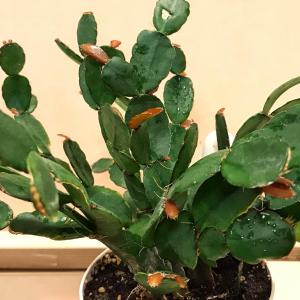


0
0
成长记
cclecombe
2018年02月12日

This has been really struggling over winter as its been so cold here but I’m hopeful it’ll pull through






0
0


